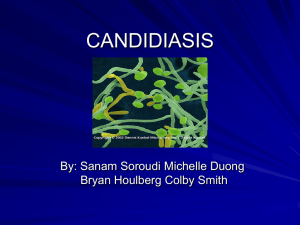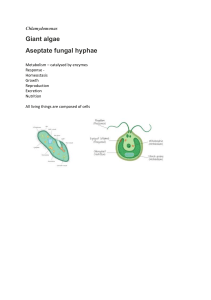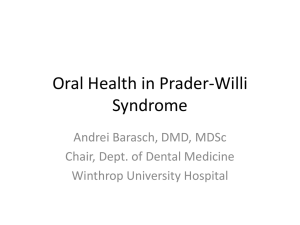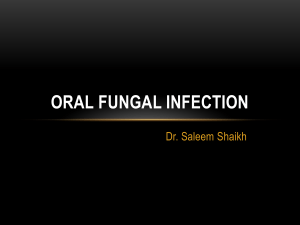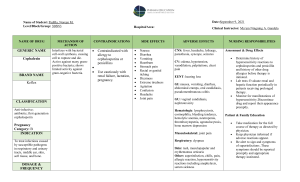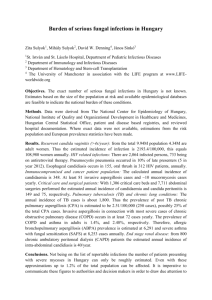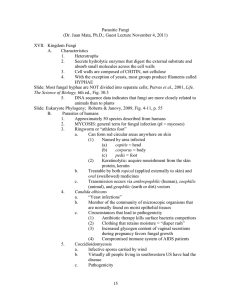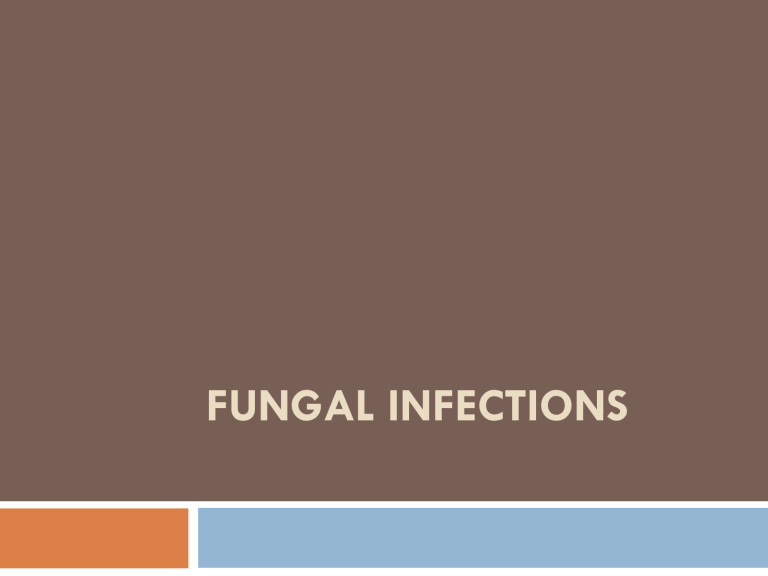
FUNGAL INFECTIONS FUNGAL INFECTIONS Fungi are eukaryotes, which have thick cell walls and ergosterol-containing cell membranes. Grow as budding yeasts or as slender filamentous hyphae. Fungi may cause superficial or deep infections. Superficial infections involve skin, mucosa, hair, nails. Deep fungal infections spread systemically and invade tissue, destroying vital organs in immunocompromised hosts, but heal in otherwise normal hosts. CANDIDIASIS (CANDIDOSIS; MONILIASIS) Etiology: Candida albicans. Most common oral fungal infection in humans. Common commensal 30 -50% of people. Spores are non-pathogenic; hyphae are pathogenic. 3 general factors determine whether clinical evidence of infections exists: Immune status of the host. Oral mucosal environment. The strain of Candida albicans. Clinical classification –Acute •Acute pseudomembranous candidiasis (thrush) •Acute atrophic candidiasis –Chronic •Chronic hyperplastic candidiasis •Chronic mucocutaneous candidiasis –Chronic familial mucocutaneous candidiasis –Chronic localized mucocutaneous candidiasis –Chronic diffuse mucocutaneous candidiasis –Candidiasis endocrinopathy syndrome Clinical types of Candidiasis 1. Pseudomembranous candidiasis (Thrush). Occurs in: Infants who acquire infection at birth. Adults using long-term broad spectrum antibiotics. Diabetics. Immune dysfunction: leukemia, HIV positive patients. Chemotherapy and radiation treated patients. Mucosa covered by white coating (pseudomembrane) resembling cottage cheese or curdled milk. Pseudomembrane can be scraped off, leaving red area. Occurs on buccal mucosa, palate, tongue. Smear with PAS stain reveals Candida hyphae. 2. Erythematous (atrophic) candidiasis. a. Acute atrophic candidiasis. Red bald tongue. Follows course of broad spectrum antibiotics. b. Central papillary atrophy of the tongue (Median rhomboid glossitis). Well demarcated red zone in midline posterior tongue due to loss of filiform papillae. May be associated with Candidal infection at other sites in the mouth: termed Chronic multifocal candidiasis. c. Angular cheilitis (perlèche). Erythema, fissuring and scaling at commissures of mouth. Causes: 20% Candida albicans alone. 60% C. albicans and Staphylococcus aureus. 20% S. aureus alone. Predisposing factors include iron deficiency anaemia, vitamin (riboflavin deficiency), over-closed vertical dimension, immunosuppression. d. Denture stomatitis (chronic atrophic candidiasis). Erythema, sometimes with petechiae, on denture bearing surfaces of maxilla. Asymptomatic; patient wears denture continuously. Smears with PAS stain usually reveals Candida hyphae. 3. Chronic hyperplastic candidiasis. White patch that cannot be removed by scraping. Usually on anterior buccal mucosa. Histology: Hyperparakeratosis, acanthosis of the epithelium; fungal hyphae and neutrophil micro-abscesses (Munro abscesses) in superficial epithelium; chronic inflammatory cell infiltrate in superficial connective tissue. Diagnosis: Presence of C. albicans hyphae in lesion, and resolution of the lesion after antifungal therapy. 4. Mucocutaneous candidiasis. Group of sporadic or inherited immune deficiency disorders which result in candidiasis of the skin and mucous membranes. Oral lesions appear as chronic hyperplastic candidiasis Diagnosis Smear preparations: –Potassium hydroxide mount –PAS stain Stains used to visualize fungal hyphae and spores –PAS –Methenamine silver Culture: –Sabouraud’s media –Cornmeal agar Histoplathological Hyperparakeratosis Elongation of rete ridges Collection of neutrophils (micro abscesses) in the superficial and upper spinous layers Chronic inflammatory cell infiltrate in connective tissue Candidal hyphae in the parakeratin layer Treatment of candidiasis. Nystatin (Mycostatin): effective and safe, but bitter taste may affect patient compliance. Ketoconazole (Nizoral): effective but can cause liver damage, therefore liver enzymes should be monitored during treatment. Use minimal effective dose, since in large doses it can also cause adrenal suppression and male hypogonadism. Fluconazole (Diflucan): more effective than ketoconazole, well absorbed, requires only once daily dosing. Disadvantage: interaction with other drugs such as phenytoin (Dilantin), oral hypoglycaemics and warfarin compounds. MUCORMYCOSIS (ZYGOMYCOSIS; PHYCOMYCOSIS). An opportunistic fungal infection occurring in debilitated patients, especially diabetics, patients on chemotherapy, patients on steroids. Etiology: Organisms of the class Zygomycetes, including Mucor and Rhizopus. Organism exhibits large, non-septate hyphae which branch at obtuse angles. There are two types: –Superficial: affecting the external ear, finger nails, skin. –Visceral: affecting the pulmonary, gastrointestinal, rhinocerebral region. Clinical features: Affects various sites, but the rhinocerebral form is most relevant to the dentist. Occurs mainly in diabetics with maxillary “sinusitis”. May present as a hemorrhagic ulcer or maxillary alveolar ridge, as a result of extension from the antrum. May cause extensive necrosis and sloughing May resemble carcinoma Histology: Extensive necrotic tissue caused by vascular thrombosis; organisms tend to invade blood vessels. Organisms are present in superficial tissues or within sinus, they are large, non septate hyphae, branching at obtuse angle Chronic inflammatory cell infiltrate. Treatment: Control primary underlying disease (diabetics). Surgical removal of the necrotic tissue. Amphotericin B. OTHER ORAL FUNGAL INFECTIONS 1. Histoplasmosis (Histoplasma capsulatum) 2. Aspergillosis 3. Cryptococcosis 4. Coccidiodomycosis 5. Paracoccidiodomycosis (Paracoccidioides brasiliensis) 6. Blastomycosis (Blastomyces dermatitidis)
